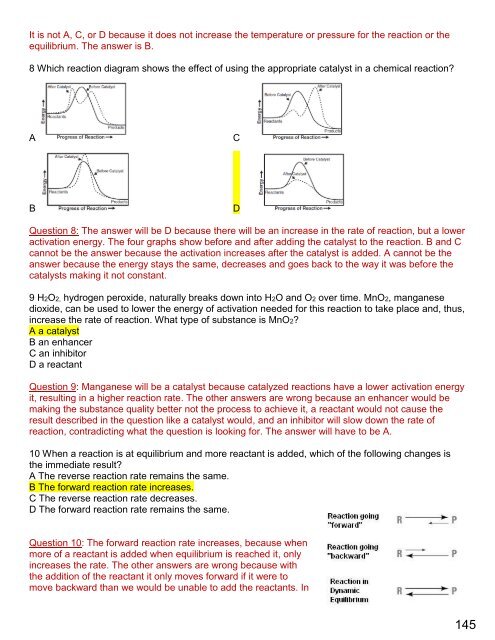You also want an ePaper? Increase the reach of your titles
YUMPU automatically turns print PDFs into web optimized ePapers that Google loves.
It is not A, C, or D because it does not increase the temperature or pressure for the reaction or the<br />
equilibrium. The answer is B.<br />
8 Which reaction diagram shows the effect of using the appropriate catalyst in a chemical reaction?<br />
A<br />
C<br />
B<br />
D<br />
Question 8: The answer will be D because there will be an increase in the rate of reaction, but a lower<br />
activation energy. The four graphs show before and after adding the catalyst to the reaction. B and C<br />
cannot be the answer because the activation increases after the catalyst is added. A cannot be the<br />
answer because the energy stays the same, decreases and goes back to the way it was before the<br />
catalysts making it not constant.<br />
9 H2O2, hydrogen peroxide, naturally breaks down into H2O and O2 over time. MnO2, manganese<br />
dioxide, can be used to lower the energy of activation needed for this reaction to take place and, thus,<br />
increase the rate of reaction. What type of substance is MnO2?<br />
A a catalyst<br />
B an enhancer<br />
C an inhibitor<br />
D a reactant<br />
Question 9: Manganese will be a catalyst because catalyzed reactions have a lower activation energy<br />
it, resulting in a higher reaction rate. The other answers are wrong because an enhancer would be<br />
making the substance quality better not the process to achieve it, a reactant would not cause the<br />
result described in the question like a catalyst would, and an inhibitor will slow down the rate of<br />
reaction, contradicting what the question is looking for. The answer will have to be A.<br />
10 When a reaction is at equilibrium and more reactant is added, which of the following changes is<br />
the immediate result?<br />
A The reverse reaction rate remains the same.<br />
B The forward reaction rate increases.<br />
C The reverse reaction rate decreases.<br />
D The forward reaction rate remains the same.<br />
Question 10: The forward reaction rate increases, because when<br />
more of a reactant is added when equilibrium is reached it, only<br />
increases the rate. The other answers are wrong because with<br />
the addition of the reactant it only moves forward if it were to<br />
move backward than we would be unable to add the reactants. In<br />
145




